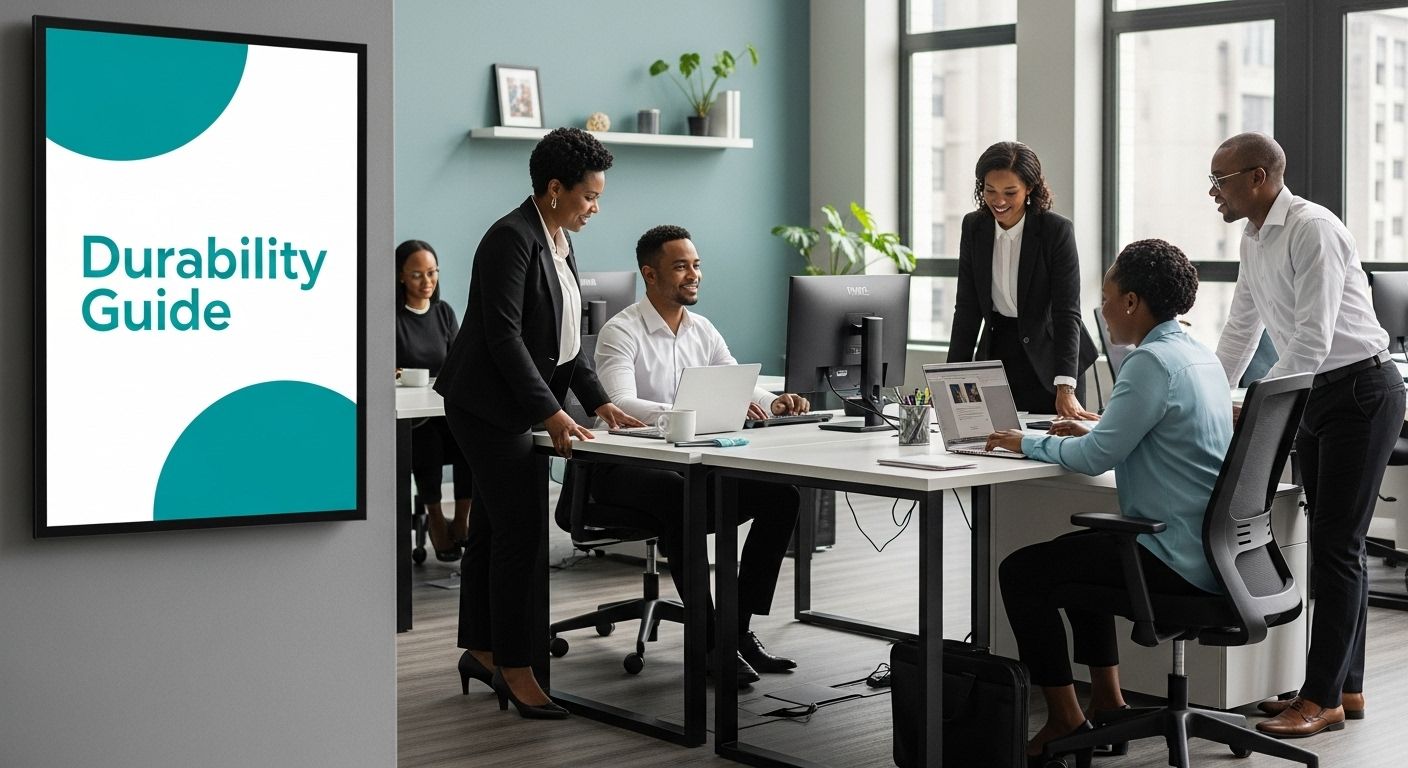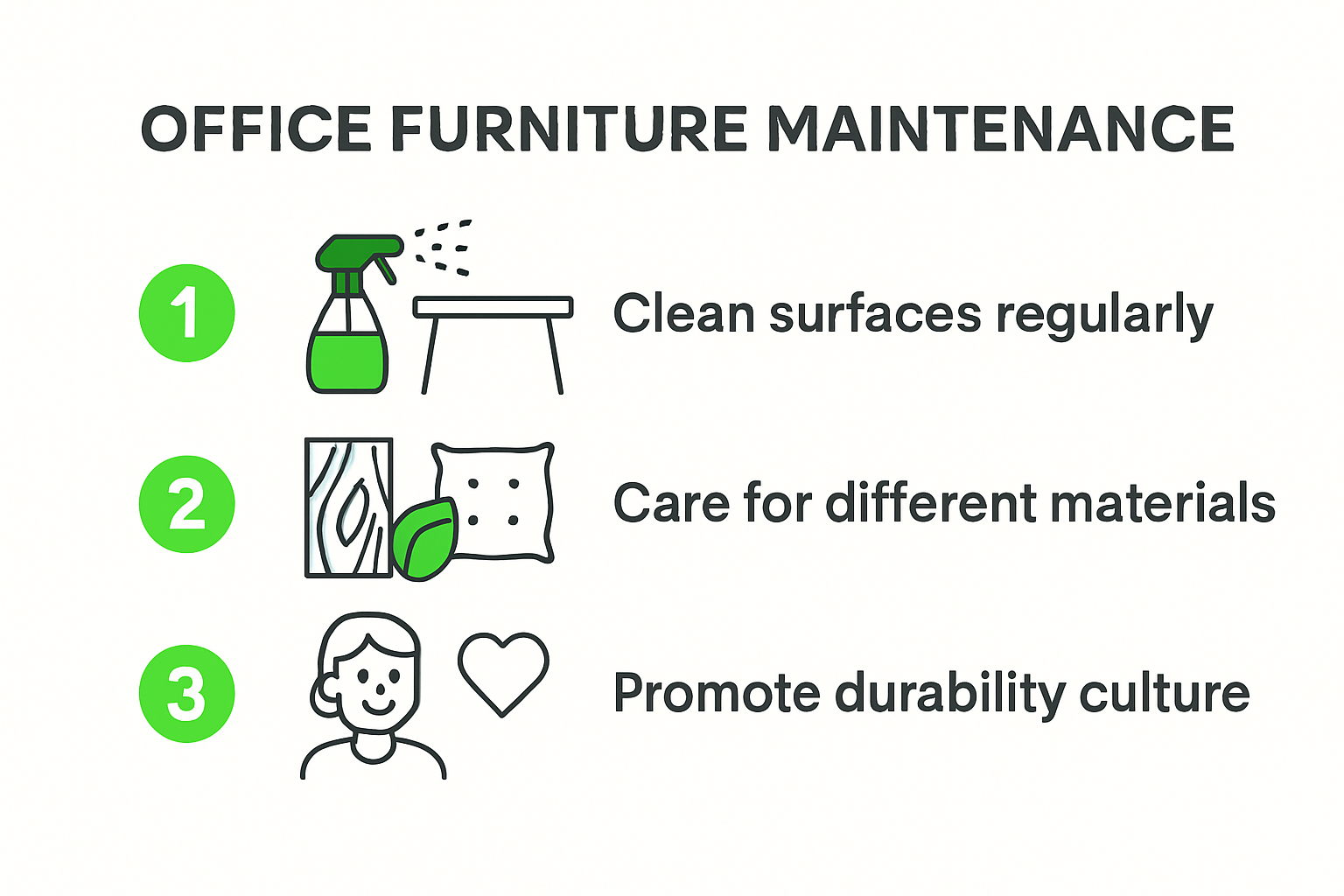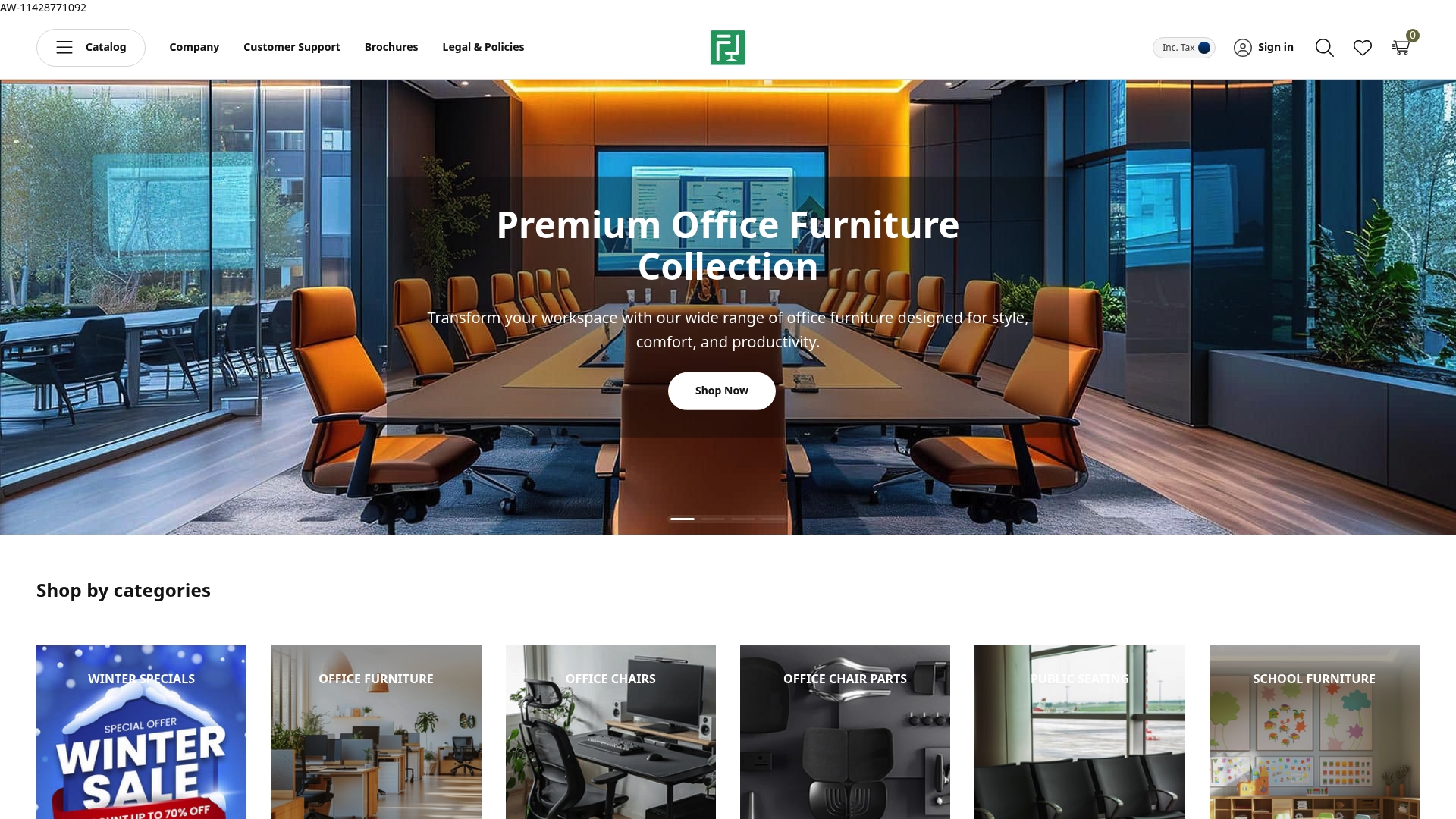Durability in Office Furniture: Guide for South African Businesses 2025
Aug 06, 2025
Durability in Office Furniture: Guide for South African Businesses 2025

Office furniture in South Africa is expected to withstand a beating, especially with busy workspaces and unpredictable loadshedding schedules. Most people assume a good-looking desk or chair is enough for the job. But the fact is, over 80 percent of discarded office furniture actually ends up in landfills, and that makes durability more than just a cost issue. Long-lasting office furniture is a bold move towards economic resilience, workplace health, and a lighter environmental footprint all in one.
Table of Contents
- Why Durability Matters For African Workspaces
- Key Materials That Ensure Long-Lasting Office Furniture
- Tips To Maintain Durability In Busy Offices
- Smart Investments: Choosing Durable Furniture For Different Sectors
Quick Summary
| Takeaway | Explanation |
|---|---|
| Durable furniture reduces long-term costs. | Investing in high-quality furniture minimizes replacement expenses and delivers consistent performance over time. |
| Ergonomics enhance employee productivity. | Utilizing robust furniture supports proper posture, reducing workplace injuries and improving overall efficiency. |
| Sustainable materials lower environmental impact. | Choosing long-lasting, eco-friendly options contributes to reduced waste and aligns with global sustainability trends. |
| Regular maintenance extends furniture lifespan. | Implementing cleaning routines and structural checks ensures durability and preserves the aesthetic appeal of office furnishings. |
| Sector-specific durability is crucial. | Different industries require tailored furniture solutions to withstand unique operational demands and maximize productivity. |
Why Durability Matters for African Workspaces
In the dynamic and challenging business environments of Africa, durability in office furniture is not just a luxury but a critical strategic investment. South African businesses face unique workplace challenges that demand furniture solutions capable of withstanding intense daily use, fluctuating environmental conditions, and long-term performance expectations.
Economic Resilience Through Robust Furniture Design
The economic landscape of African workspaces requires furniture that goes beyond mere aesthetic appeal. Research from the Centers for Disease Control and Prevention highlights that durable office furniture plays a pivotal role in creating safer, more efficient work environments. In South African contexts, where businesses often operate with limited resources, investing in high-quality, long-lasting furniture becomes a fundamental strategy for reducing long-term operational costs.
Durable furniture minimizes frequent replacement expenses, offers consistent performance, and maintains workplace aesthetics over extended periods. This approach is particularly crucial in regions experiencing economic volatility, where every rand spent must deliver maximum value and reliability.
Workplace Health and Productivity Considerations
Occupational Safety and Health Administration guidelines emphasize that furniture durability directly correlates with employee health and productivity. In African workspaces, where ergonomic standards are increasingly prioritized, robust furniture prevents workplace injuries, supports proper posture, and creates environments conducive to sustained professional performance.
Quality office furniture that withstands rigorous daily use reduces the risk of structural failures, potential workplace accidents, and unexpected disruptions. For South African businesses competing in global markets, maintaining consistent workplace infrastructure is not just about comfort but about demonstrating professional reliability and commitment to employee well-being.
Environmental and Sustainability Factors
Durability in office furniture represents more than just economic sense it embodies a commitment to sustainable business practices. African businesses are increasingly recognizing that investing in long-lasting furniture reduces environmental waste, minimizes carbon footprint, and aligns with global sustainability trends.
By selecting furniture designed to endure multiple years of intensive use, companies can significantly reduce their ecological impact. This approach resonates with modern workforce expectations, where employees and clients alike appreciate organizations demonstrating environmental consciousness through strategic procurement decisions.
The narrative of durability in African workspaces is fundamentally about resilience, efficiency, and forward-thinking investment. It transcends simple furniture selection and becomes a strategic decision that impacts workplace culture, economic performance, and organizational reputation.
Key Materials That Ensure Long-Lasting Office Furniture
Selecting the right materials is fundamental to creating durable office furniture that can withstand the demanding work environments of South African businesses. The choice of materials directly impacts the longevity, performance, and overall value of office furniture investments.
Metal Structures: The Backbone of Durability
Research from the Environmental Protection Agency highlights the importance of using high-quality materials with significant recycled content. In office furniture, metal materials like steel and aluminum stand out as premier choices for durability. Metal furniture sources demonstrate that steel offers exceptional tensile strength, making it ideal for creating robust structural components such as chair frames, desk legs, and support structures.
Aluminum presents another excellent option, characterized by its lightweight nature and remarkable corrosion resistance. These properties make metal materials particularly suitable for African workspaces, where furniture must endure challenging environmental conditions, frequent use, and potential temperature fluctuations. Companies can explore our industrial chair options for examples of metal-based furniture designed for maximum durability.
Engineered Wood and Composite Materials
Stellar Global research emphasizes the significance of engineered wood products like Melamine-Faced Chipboard (MFC) in creating long-lasting office furniture. MFC offers remarkable advantages including resistance to scratches, stains, and moisture, while providing a cost-effective solution for businesses seeking quality furniture.
Modern engineered wood materials incorporate advanced manufacturing techniques that enhance structural integrity and performance. These materials can withstand significant daily wear and tear, making them an excellent choice for high-traffic office environments. The ability to produce MFC in various colors and patterns also allows businesses to maintain aesthetic flexibility without compromising on durability.
Sustainable and Innovative Material Choices
Beyond traditional materials, emerging sustainable options are transforming the office furniture landscape. The Environmental Protection Agency guidelines recommend materials with high recycled content, encouraging manufacturers to develop innovative, eco-friendly solutions.
Recycled steel and aluminum can contain up to 75-100% recovered materials, while wood-based components can incorporate 80-100% recovered wood. These sustainable approaches not only create durable furniture but also align with growing environmental consciousness in the corporate sector.
For South African businesses, selecting the right materials is more than a purchasing decision it represents a strategic investment in workplace infrastructure. By prioritizing durability through carefully chosen materials, companies can create work environments that are resilient, efficient, and capable of supporting long-term organizational growth and productivity.
Here is a comparison table summarizing the key characteristics of primary office furniture materials discussed in this section:
| Material Type | Key Characteristics | Durability Benefits | Suitability in SA Context |
|---|---|---|---|
| Steel | High tensile strength, strong, heavy, recyclable | Excellent structural support, long-lasting | Withstands frequent use, volatile climate |
| Aluminium | Lightweight, corrosion-resistant, recyclable | Easy to move, rust-resistant, durable | Handles temperature & humidity changes |
| Engineered Wood | Scratch/stain/moisture-resistant, customisable | Maintains appearance, resists wear, cost-effective | High-traffic, flexible style options |
| Recycled Materials | High recovered content, sustainable | Reduces waste, eco-friendly, robust | Aligns with SA sustainability goals |
Tips to Maintain Durability in Busy Offices
 Maintaining the durability of office furniture requires proactive strategies and consistent care, especially in high-traffic South African work environments where furniture experiences intense daily use. Implementing targeted maintenance approaches can significantly extend the lifespan of office furniture and protect critical business investments.
Maintaining the durability of office furniture requires proactive strategies and consistent care, especially in high-traffic South African work environments where furniture experiences intense daily use. Implementing targeted maintenance approaches can significantly extend the lifespan of office furniture and protect critical business investments.
Regular Cleaning and Surface Protection
Research from the University of North Carolina Environment, Health and Safety emphasizes the importance of routine furniture maintenance. Regular cleaning prevents dirt accumulation, surface degradation, and potential material breakdown. For different office furniture materials, specific cleaning protocols are essential.
Metal furniture requires gentle cleaning with non-abrasive cloths and mild detergents to prevent scratching or corrosion. Wooden surfaces benefit from specialized wood cleaners that nourish and protect the material. Upholstered chairs demand vacuum cleaning and periodic deep cleaning to remove dust, stains, and potential bacterial buildup. Implementing a structured cleaning schedule ensures furniture maintains its aesthetic appeal and structural integrity.
Preventative Maintenance and Structural Checks
Proactive maintenance involves regular structural assessments and immediate addressing of potential issues. Businesses should establish quarterly furniture inspection protocols where maintenance teams or designated staff members systematically examine office furniture for signs of wear, loose components, or potential structural weaknesses.
Key inspection points include checking chair wheels for smooth rotation, examining desk joints and connections, testing drawer mechanisms, and assessing chair hydraulic systems. Identifying and resolving minor issues prevents escalation into major repairs or complete furniture replacement. Simple actions like tightening screws, lubricating moving parts, and replacing worn components can dramatically extend furniture lifespan.
Training and Workplace Culture of Care
Creating a workplace culture that values furniture preservation is crucial for long-term durability. Employee training programs should include guidelines on proper furniture usage, understanding weight limitations, and recognizing potential damage indicators. This approach transforms maintenance from a reactive to a proactive strategy.
Encourage employees to report furniture issues immediately, treat office equipment with respect, and understand the economic and environmental implications of premature furniture replacement. Implementing a simple reporting system where staff can quickly communicate maintenance needs can prevent minor damages from becoming significant problems.
Additionally, consider establishing clear workplace guidelines about furniture usage. This might include rules about sitting on desk edges, avoiding excessive weight on chair wheels, and keeping food and liquids away from electronic equipment and delicate surfaces.
Ultimately, maintaining office furniture durability is a collective responsibility. By combining professional maintenance techniques, systematic inspections, and a culture of care, South African businesses can maximize their furniture investments, create safer work environments, and demonstrate commitment to sustainable workplace management.
Below is a process table outlining key steps to maintain office furniture durability, as described in this section:
| Step | Action | Purpose |
|---|---|---|
| 1. Regular Cleaning | Use material-appropriate cleaners and schedules | Prevent surface degradation, maintain looks |
| 2. Surface Protection | Apply protective measures to wood/metal (e.g., covers, mats) | Reduce scratches, stains, and moisture exposure |
| 3. Structural Checks | Inspect for loose parts, wear, or damage quarterly | Catch maintenance needs early |
| 4. Component Maintenance | Tighten screws, lubricate, replace worn parts | Extend furniture lifespan, prevent failures |
| 5. Employee Training | Educate on proper usage, care, and weight limits | Build culture of care, minimize misuse |
| 6. Reporting & Prompt Repairs | Encourage staff to report issues; fix or escalate them promptly | Minimize escalation from small to bigger issues |
Smart Investments: Choosing Durable Furniture for Different Sectors
Investing in durable office furniture represents a strategic decision that transcends mere aesthetic considerations. Different business sectors require specialized furniture solutions that can withstand unique operational demands while delivering long-term value and performance.
Corporate and Professional Environments
Research from Fortune Business Insights highlights wooden office furniture as a premier choice for professional settings, prized for its strength, durability, and elegant design. Corporate environments demand furniture that can endure constant use, support ergonomic requirements, and maintain a sophisticated appearance.
Key considerations for corporate furniture include modular designs that facilitate workspace flexibility, robust construction that supports extended use, and materials that resist wear from daily interactions. For instance, executive chairs and conference tables must withstand frequent use while maintaining structural integrity. Our steel-top laptop tables exemplify the type of versatile, durable solutions modern businesses require.
Educational and Training Sectors
Educational institutions and training centers face unique furniture durability challenges. These spaces experience high-traffic environments with diverse user groups, demanding furniture that can withstand significant physical stress. The Environmental Protection Agency’s research indicates that over 80% of discarded office furniture ends up in landfills, underscoring the importance of selecting robust, long-lasting solutions for educational settings.
Durable furniture in these sectors must accommodate frequent rearrangements, support varied learning configurations, and resist potential damage from continuous student interactions. Materials like reinforced steel frames, impact-resistant surfaces, and easy-to-clean upholstery become critical selection criteria. Furniture must balance durability with comfort and adaptability to support dynamic learning environments.
Healthcare and Specialized Workspace Requirements
Panels Systems Unlimited research emphasizes that investing in high-quality furniture delivers substantial long-term financial benefits by reducing replacement frequency and minimizing workflow disruptions. In healthcare settings, this principle becomes even more critical.
Medical environments require furniture that meets stringent hygiene standards, supports specialized equipment, and can be thoroughly sanitized. Stainless steel components, non-porous surfaces, and modular designs that facilitate easy cleaning become essential. Furniture must withstand harsh cleaning chemicals, potential medical equipment impacts, and constant patient interactions while maintaining a professional, calming aesthetic.
Across all sectors, the fundamental principle remains consistent: durable furniture is an investment, not an expense. By carefully selecting furniture that matches specific operational requirements, businesses can create workspaces that support productivity, reflect professional standards, and deliver sustained value over extended periods. The right furniture becomes more than a physical asset it transforms into a strategic tool supporting organizational efficiency and employee well-being.

Frequently Asked Questions
What materials contribute to the durability of office furniture?
Materials that enhance durability include metal structures like steel and aluminum, engineered wood products like Melamine-Faced Chipboard (MFC), and sustainable choices such as recycled materials. These materials are designed to withstand daily wear and tear, ensuring long-lasting performance.
How can regular maintenance improve the longevity of office furniture?
Regular maintenance such as cleaning, structural checks, and timely repairs can significantly extend the lifespan of office furniture. Implementing a cleaning schedule and training employees to report issues can prevent minor problems from escalating into costly damages.
Why is ergonomic design important in durable office furniture?
Ergonomic design is essential as it promotes proper posture and reduces workplace injuries. Durable furniture that supports ergonomic principles not only enhances employee comfort but also contributes to higher productivity and overall workplace health.
What are the benefits of choosing sustainable office furniture materials?
Choosing sustainable materials promotes environmental responsibility by reducing waste and carbon footprint. Additionally, sustainable options often include recycled content, which can contribute to cost savings over time due to their durability and lower replacement needs.
Future-Proof Your Workspace With Durable Office Solutions
Have you noticed your office furniture wearing out too quickly or failing to withstand daily stresses? The article highlights how South African businesses lose time and money by replacing desks and chairs that do not last. Frequent repairs and replacements can drain budgets, hurt productivity, and send the wrong signal about your company’s standards. Office Stock understands these pain points and offers a smarter way forward. Our premium products are engineered for busy local workspaces, making use of robust materials like reinforced steel, engineered wood, and easy-clean finishes. Each solution is chosen for long-lasting comfort, optimal support, and a professional look that lasts.

Transform your workspace into a place where employees thrive and furniture endures. Visit Office Stock’s main site to explore our full range of ergonomic chairs and durable steel-top laptop tables designed to save you money in the long run. Upgrade now so your business is ready for 2025 and beyond.
